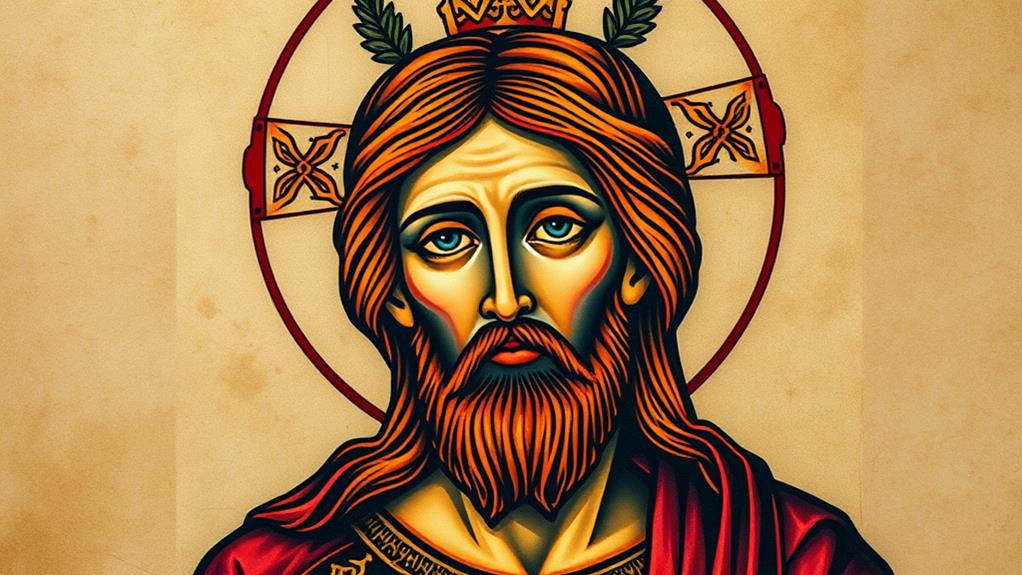I'm truly fascinated by Icon of Christ Pantocrator tattoos. They beautifully intertwine deep spiritual significance with artistic expression. These tattoos evoke centuries of history, capturing Christ's divine sovereignty and dual nature. I love how each design reflects the artist's unique interpretation, whether vibrant Byzantine styles or modern abstract lines. The placement options range from chest to forearm, allowing a personal touch that sparks meaningful conversations. Caring for a Pantocrator tattoo guarantees its longevity and vibrance. Each tattoo isn't just art; it's a declaration of faith, evolving with one's spiritual journey—there's so much more to explore about this enthralling subject.
Historical Background
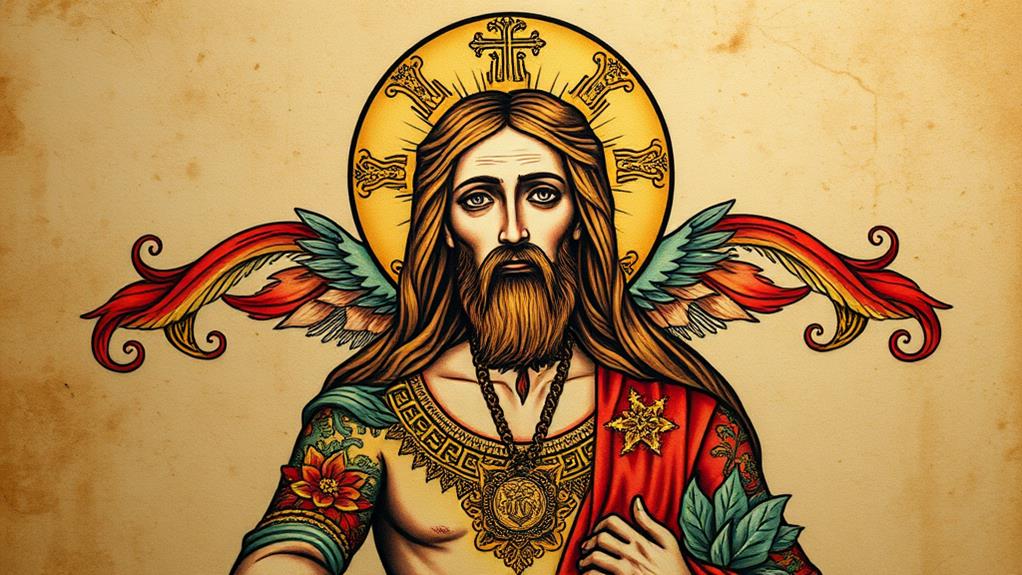
The image of Christ Pantocrator, depicted as the all-powerful ruler of the universe, has a rich history that stretches back to the early Christian era.
I've always been fascinated by how this striking icon emerged from the depths of Byzantine art, reflecting the theological debates of its time.
The earliest representations date back to the sixth century, often found adorning the apse of churches, where the faithful could gaze upon Christ's divine authority.
As I plunge deeper into its origins, I discover that the Pantocrator icon wasn't just a form of artistic expression; it was a statement of power and divine governance.
The imagery served to reinforce Christian doctrine, asserting Christ's role as both judge and savior.
I can almost envision the artists, painstakingly applying gold leaf and vibrant colors, pouring their devotion into each brushstroke, capturing an essence that transcends mere aesthetics.
Throughout history, this icon has evolved, yet its core message remains unchanged.
It's a reminder of the divine presence in our lives, a source of inspiration for those of us who choose to carry its image as tattoos, linking us to a tradition that spans centuries.
Symbolism of the Pantocrator
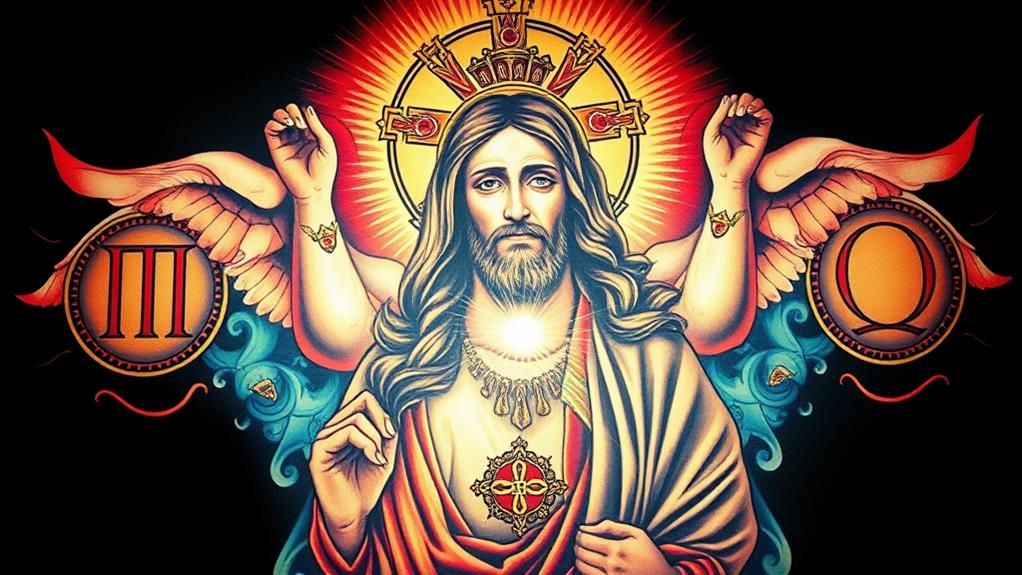
Throughout centuries, the Pantocrator icon has embodied profound symbolism that resonates deeply with believers.
As I explore its layers of meaning, I can't help but appreciate how it captures the essence of divine authority and compassion. The term "Pantocrator" translates to "Almighty" or "Ruler of All," and this duality is reflected in the imagery.
- Divine Sovereignty: The Pantocrator represents Christ's supreme power over the universe.
- Judgment and Mercy: The distinct expressions on His face convey both His role as judge and His capacity for mercy.
- Unity of Humanity and Divinity: The icon encapsulates the union of Christ's human and divine natures, reminding us of His dual role.
- Call to Worship: The posture and gaze invite believers to recognize His authority and seek His guidance.
- Spiritual Protection: Many devotees view the image as a shield against adversity, offering comfort in times of struggle.
In essence, the Pantocrator isn't just an image; it's a powerful reminder of faith, hope, and divine presence in our lives.
Artistic Interpretations
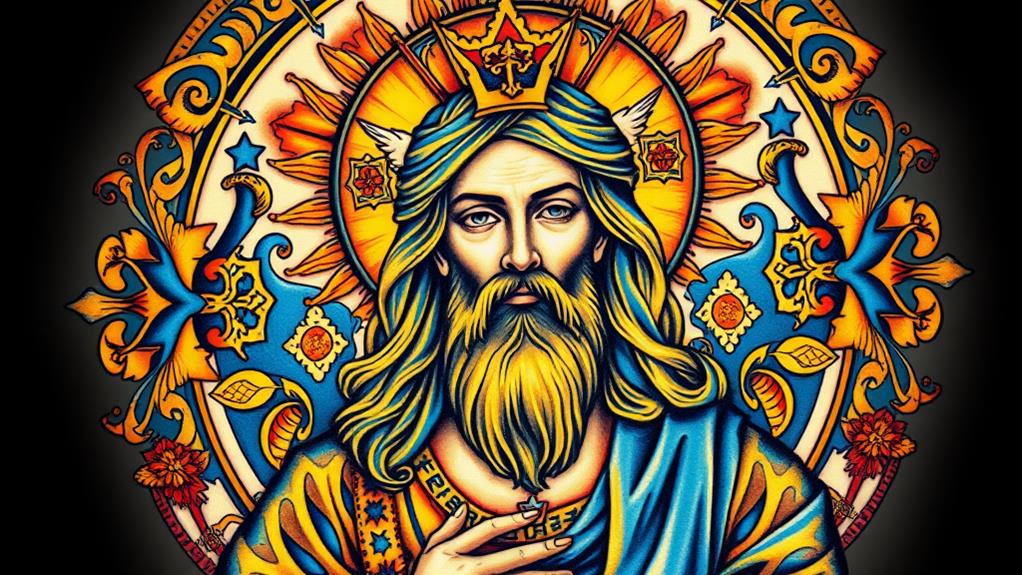
In recent years, I've been captivated by the diverse artistic interpretations of the Pantocrator icon, which span cultures and time periods.
Each version tells a unique story, reflecting the artist's individual style and the cultural context in which it was created. I've marveled at how Byzantine artists captured divine majesty through intricate details and rich color palettes, often using gold leaf to invoke a sense of otherworldliness.
Then there are the modern interpretations, where contemporary artists reimagine the Pantocrator with bold lines and abstract forms, infusing a fresh energy into this ancient symbol.
These pieces often evoke a sense of personal connection, as they blend traditional elements with modern aesthetics, making the icon relevant to today's audience.
I've found it fascinating how tattoos of the Pantocrator can incorporate elements from various artistic traditions, allowing for a deeply personal expression of faith or spirituality.
Some designs emphasize the serene gaze of Christ, while others focus on the intricate halo surrounding His head.
Each tattoo becomes a canvas, merging theology and artistry, making the wearer a walking declaration to both belief and creativity.
Placement and Size Options
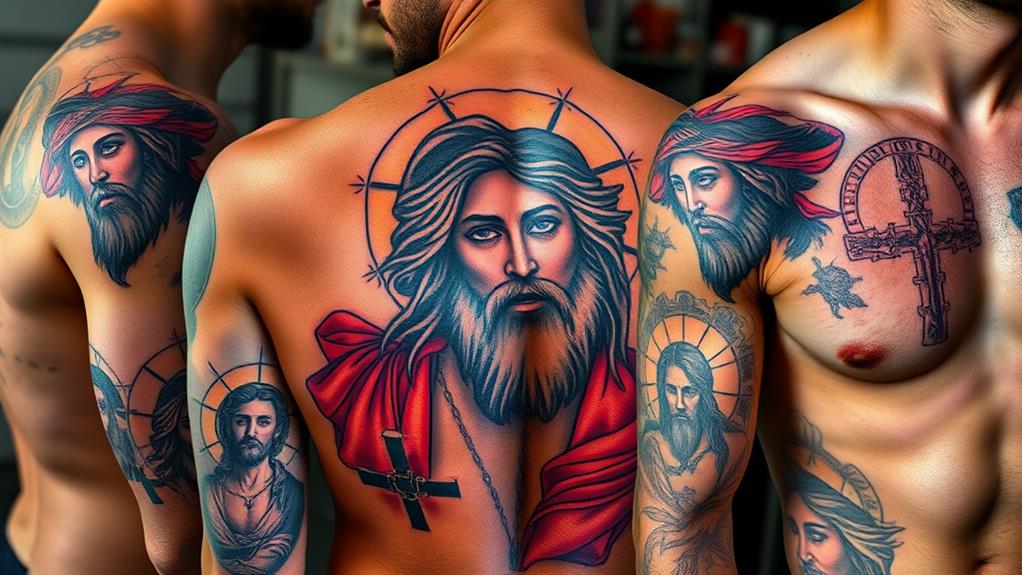
When choosing the perfect spot for my Christ Pantocrator tattoo, I can't help but consider how placement can elevate its significance.
From the expansive canvas of my back to the intimate space on my forearm, each location offers a unique way to showcase this powerful icon.
Size variations also play a vital role; a larger piece can command attention, while a smaller design can whisper its meaning quietly.
Ideal Body Locations
Choosing the ideal body location for a Christ Pantocrator tattoo can make all the difference in its impact and meaning.
This divine image carries deep symbolism, so where you place it should resonate with your personal connection to the art and the message it conveys.
- Upper Arm: A great canvas that's easy to show off or cover up.
- Back: Offers a larger space for intricate details, making the design more striking.
- Chest: Close to the heart, symbolizing deep faith and personal significance.
- Forearm: A visible spot that sparks conversations and allows for daily reflection.
- Thigh: A unique placement that offers a personal touch and can be easily hidden.
Each location has its own flair, and I love how it can influence the tattoo's overall vibe.
Whether you're looking for something bold and prominent or subtle and intimate, choosing the right spot is just as crucial as the design itself.
Ultimately, it's about what feels right for you and how you want to express this sacred art.
Size Variations Explained
The size of your Christ Pantocrator tattoo can dramatically alter its presence and emotional impact.
When I consider placement, I often reflect on how a small, detailed design can nestle beautifully on my wrist, offering a personal connection that feels intimate.
Conversely, a larger piece on my back or chest transforms into a commanding statement, inviting admiration and contemplation from anyone who sees it.
For me, the size also dictates the level of detail I can incorporate.
A smaller tattoo might focus on the face of Christ, capturing His serene gaze, while a grander design allows for rich embellishments like halo or background elements that deepen the story being told.
Choosing the right size is also about lifestyle.
I've learned that if I want my tattoo to be a constant reminder of faith, I might opt for a more visible area in a medium size, ensuring it's a part of my daily life.
Ultimately, whether it's a modest piece or an elaborate mural, the size shapes how I express my spirituality and connects me to the divine in a way that feels uniquely powerful.
Care and Maintenance Tips
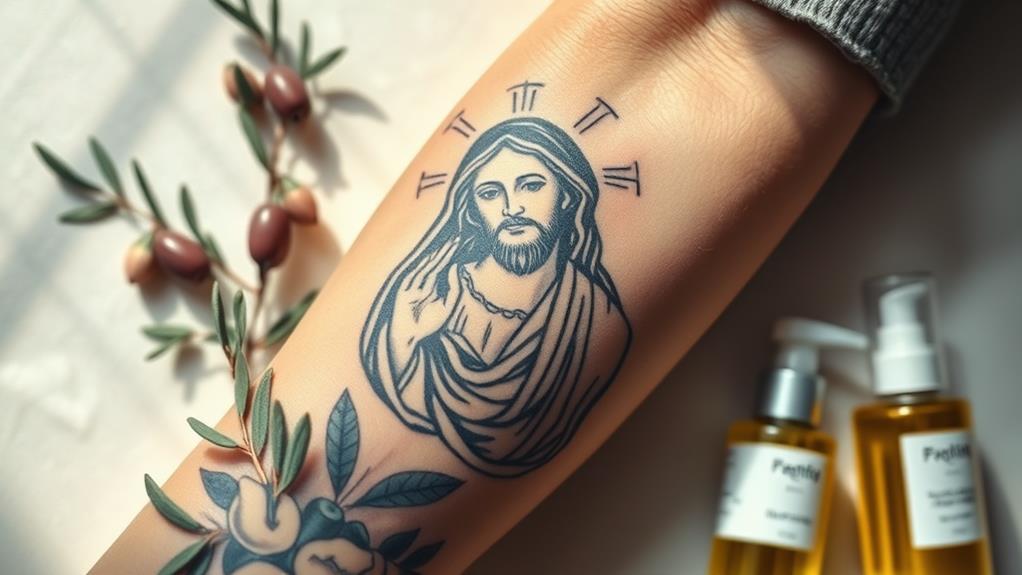
Caring for your Icon of Christ Pantocrator tattoo requires a thoughtful approach to maintain its beauty and significance.
I've learned that proper care can make a world of difference in preserving the intricate details and vibrant colors of this divine artwork.
- Keep it clean: Gently wash the tattoo with mild soap and lukewarm water, avoiding harsh chemicals.
- Moisturize regularly: Use a fragrance-free lotion or tattoo-specific ointment to keep the skin hydrated.
- Avoid sun exposure: Protect your tattoo from direct sunlight; consider wearing clothing over it or using a high-SPF sunscreen.
- Don't scratch or pick: Resist the urge to scratch during the healing process, as this can lead to fading or scarring.
- Stay hydrated: Drinking plenty of water helps maintain skin elasticity, which contributes to the longevity of your tattoo.
Personal Stories and Experiences
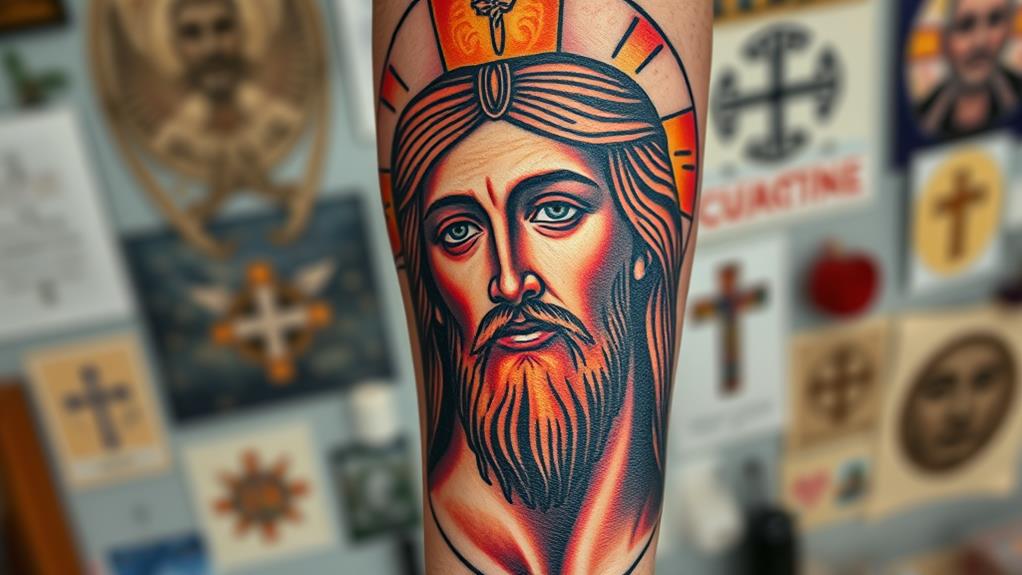
When I first decided to get the Christ Pantocrator tattoo, it felt like more than just ink on skin; it was a spiritual awakening.
Each detail of the design encapsulated my transformative journey, connecting me to a deeper faith and purpose.
As I share my story, I invite others to reflect on how their tattoos have shaped their own spiritual paths.
Spiritual Significance Explained
Amidst the ink and artistry, I found a profound connection to the Icon of Christ Pantocrator that transcended mere aesthetics.
Each color and line seemed to pulse with spiritual energy, whispering stories of faith, resilience, and divine love.
As I sat in the tattoo chair, I reflected on what this image meant to me, and I realized it encapsulated several pivotal aspects of my journey:
- Divine Presence: A constant reminder that I'm never alone.
- Strength in Trials: Symbolizing guidance during my darkest moments.
- Faith and Understanding: Deepening my spiritual relationship with God.
- Community Connection: Sharing a bond with others who value this icon.
- Personal Transformation: Marking my growth and commitment to my beliefs.
Each session transformed not just my skin, but my soul.
The tattoo became a conduit for introspection, challenging me to explore my spirituality more deeply.
I've shared my experience with others, discovering that many feel similarly drawn to this sacred imagery.
Through these tattoos, we're not just making art; we're forging a pathway to divine understanding, weaving our stories into a larger tapestry of faith and devotion.
Transformative Tattoo Journeys
The journey of ink on skin often mirrors our inner transformations, revealing layers of meaning that extend far beyond the surface.
When I decided to get my Christ Pantocrator tattoo, I wasn't just choosing a design; I was embracing a pivotal moment in my spiritual evolution.
Each stroke of the needle felt like a conversation with my soul, a dialogue that spoke of faith, resilience, and redemption.
As the artist worked, I reflected on how this image encapsulated my struggles and triumphs.
The depiction of Christ as the all-powerful ruler resonated deeply with me, reminding me that I, too, have the strength to overcome life's challenges.
I felt liberated in that chair, as if each carefully placed dot of ink was shedding the weight of past doubts.
Now, every time I catch a glimpse of my tattoo, I'm reminded of my journey.
It's more than skin deep; it's a declaration to my faith and personal growth.
The Christ Pantocrator is a beacon of hope, guiding me through the tumultuous waves of life, a constant reminder that transformation is possible, and that my spirit is, indeed, resilient.
Frequently Asked Questions
What Is the Origin of the Term "Pantocrator"?
I've learned that "pantocrator" originates from the Greek word "pantokrator," meaning "ruler of all." It embodies divine authority and omnipotence, often depicting Christ in art, symbolizing His sovereignty over heaven and earth.
Are There Specific Colors Associated With Pantocrator Tattoos?
When I explore Pantocrator tattoos, I notice rich colors like deep blue, gold, and crimson. These hues symbolize divinity, authority, and passion, transforming the art into a powerful statement of faith and personal expression.
Can Pantocrator Tattoos Be Combined With Other Designs?
I love combining Pantocrator tattoos with other elements. Blending intricate patterns or nature motifs creates a unique story. It adds depth and personal significance, making the design truly my own. Each piece becomes a masterpiece.
What Are the Common Styles for Pantocrator Tattoos?
I've noticed common styles for Pantocrator tattoos often include realistic portraiture, intricate Byzantine patterns, and bold line work. Each style captures the essence of divinity, allowing for personal expression while honoring the rich tradition behind these images.
Are There Any Cultural Taboos Regarding Pantocrator Tattoos?
I've noticed that some people view Pantocrator tattoos as controversial, given their religious significance. In certain cultures, depicting sacred imagery on the body can be frowned upon, sparking debates about respect and personal expression.
